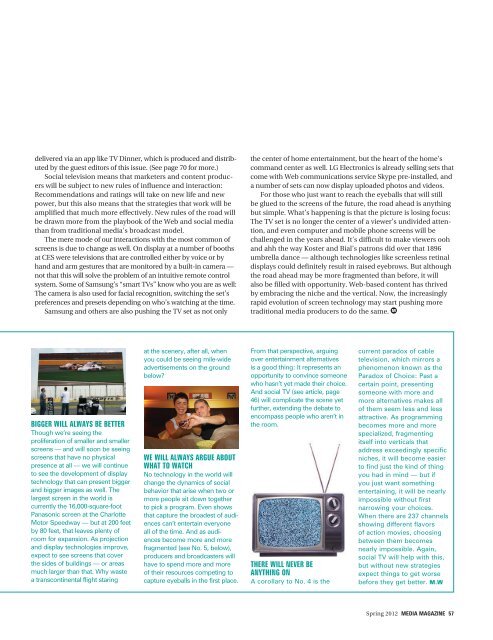THIRD ANNUAL SCREENS ISSUE - MediaPost
THIRD ANNUAL SCREENS ISSUE - MediaPost
THIRD ANNUAL SCREENS ISSUE - MediaPost
You also want an ePaper? Increase the reach of your titles
YUMPU automatically turns print PDFs into web optimized ePapers that Google loves.
delivered via an app like TV Dinner, which is produced and distributed<br />
by the guest editors of this issue. (See page 70 for more.)<br />
Social television means that marketers and content producers<br />
will be subject to new rules of influence and interaction:<br />
Recommendations and ratings will take on new life and new<br />
power, but this also means that the strategies that work will be<br />
amplified that much more effectively. New rules of the road will<br />
be drawn more from the playbook of the Web and social media<br />
than from traditional media’s broadcast model.<br />
The mere mode of our interactions with the most common of<br />
screens is due to change as well. On display at a number of booths<br />
at CES were televisions that are controlled either by voice or by<br />
hand and arm gestures that are monitored by a built-in camera —<br />
not that this will solve the problem of an intuitive remote control<br />
system. Some of Samsung’s “smart TVs” know who you are as well:<br />
The camera is also used for facial recognition, switching the set’s<br />
preferences and presets depending on who’s watching at the time.<br />
Samsung and others are also pushing the TV set as not only<br />
BIGGER WILL ALWAYS BE BETTER<br />
Though we’re seeing the<br />
proliferation of smaller and smaller<br />
screens — and will soon be seeing<br />
screens that have no physical<br />
presence at all — we will continue<br />
to see the development of display<br />
technology that can present bigger<br />
and bigger images as well. The<br />
largest screen in the world is<br />
currently the 16,000-square-foot<br />
Panasonic screen at the Charlotte<br />
Motor Speedway — but at 200 feet<br />
by 80 feet, that leaves plenty of<br />
room for expansion. As projection<br />
and display technologies improve,<br />
expect to see screens that cover<br />
the sides of buildings — or areas<br />
much larger than that. Why waste<br />
a transcontinental flight staring<br />
at the scenery, after all, when<br />
you could be seeing mile-wide<br />
advertisements on the ground<br />
below?<br />
WE WILL ALWAYS ARGUE ABOUT<br />
WHAT TO WATCH<br />
No technology in the world will<br />
change the dynamics of social<br />
behavior that arise when two or<br />
more people sit down together<br />
to pick a program. Even shows<br />
that capture the broadest of audiences<br />
can’t entertain everyone<br />
all of the time. And as audiences<br />
become more and more<br />
fragmented (see No. 5, below),<br />
producers and broadcasters will<br />
have to spend more and more<br />
of their resources competing to<br />
capture eyeballs in the first place.<br />
the center of home entertainment, but the heart of the home’s<br />
command center as well. LG Electronics is already selling sets that<br />
come with Web communications service Skype pre-installed, and<br />
a number of sets can now display uploaded photos and videos.<br />
For those who just want to reach the eyeballs that will still<br />
be glued to the screens of the future, the road ahead is anything<br />
but simple. What’s happening is that the picture is losing focus:<br />
The TV set is no longer the center of a viewer’s undivided attention,<br />
and even computer and mobile phone screens will be<br />
challenged in the years ahead. It’s difficult to make viewers ooh<br />
and ahh the way Koster and Bial’s patrons did over that 1896<br />
umbrella dance — although technologies like screenless retinal<br />
displays could definitely result in raised eyebrows. But although<br />
the road ahead may be more fragmented than before, it will<br />
also be filled with opportunity. Web-based content has thrived<br />
by embracing the niche and the vertical. Now, the increasingly<br />
rapid evolution of screen technology may start pushing more<br />
traditional media producers to do the same.<br />
From that perspective, arguing<br />
over entertainment alternatives<br />
is a good thing: It represents an<br />
opportunity to convince someone<br />
who hasn’t yet made their choice.<br />
And social TV (see article, page<br />
46) will complicate the scene yet<br />
further, extending the debate to<br />
encompass people who aren’t in<br />
the room.<br />
THERE WILL NEVER BE<br />
ANYTHING ON<br />
A corollary to No. 4 is the<br />
current paradox of cable<br />
television, which mirrors a<br />
phenomenon known as the<br />
Paradox of Choice: Past a<br />
certain point, presenting<br />
someone with more and<br />
more alternatives makes all<br />
of them seem less and less<br />
attractive. As programming<br />
becomes more and more<br />
specialized, fragmenting<br />
itself into verticals that<br />
address exceedingly specific<br />
niches, it will become easier<br />
to find just the kind of thing<br />
you had in mind — but if<br />
you just want something<br />
entertaining, it will be nearly<br />
impossible without first<br />
narrowing your choices.<br />
When there are 237 channels<br />
showing different flavors<br />
of action movies, choosing<br />
between them becomes<br />
nearly impossible. Again,<br />
social TV will help with this,<br />
but without new strategies<br />
expect things to get worse<br />
before they get better. M.W<br />
Spring 2012 MEDIA MAGAZINE 57








